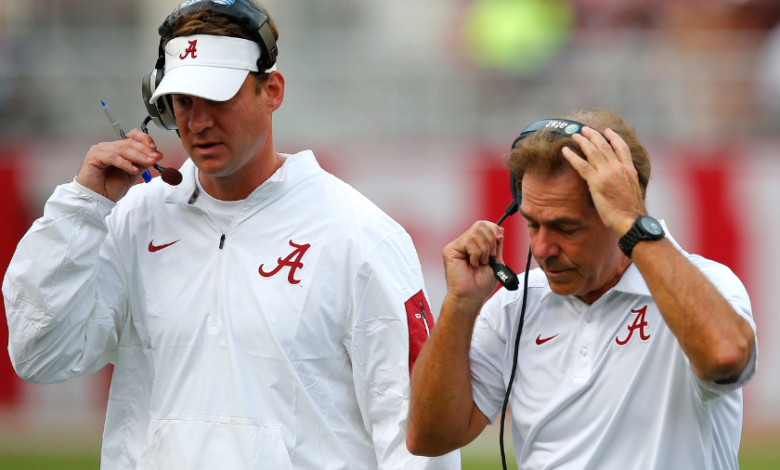Nick Saban’s coaching tree may be his greatest achievement, with numerous former assistants now head coaches, showcasing his impact on college football beyond Alabama.

Nick Saban is widely regarded as one of the greatest college football coaches of all time. His unmatched success at the University of Alabama, where he has won multiple national championships, reshaped the culture of college football, and established a legacy of excellence, is well documented. However, while Saban’s success is most directly linked to his accomplishments at Alabama, one of his most enduring and significant achievements may not lie solely in the championships, titles, and accolades he has won with the Crimson Tide. Instead, it may be the extensive coaching tree he has cultivated over his illustrious career.
Saban’s coaching tree is a testament to his ability to mentor, develop, and inspire not just players, but future coaching talent. His influence on the game stretches far beyond his time at Alabama, with numerous former assistants and protégés finding success as head coaches at other schools and in the NFL. These coaches are not just a reflection of Saban’s system but also embody the leadership principles, work ethic, and attention to detail that have become hallmarks of Saban’s coaching philosophy.
This article explores how Nick Saban’s coaching tree has become one of his greatest achievements, the impact his former assistants have had on college football, and how his leadership style has shaped the next generation of coaching talent.
The Rise of Nick Saban
Before diving into the impact of his coaching tree, it’s important to understand the foundation of Nick Saban’s success. Saban’s coaching career spans several decades, with stops at multiple prestigious programs. After an early career in the NFL, Saban made a name for himself as the head coach at Michigan State, where he turned the Spartans into a competitive force in the Big Ten.
But it was his time at LSU (2000-2004) that really marked the beginning of Saban’s ascent to college football’s upper echelon. After winning a national championship with the Tigers in 2003, Saban took the leap to the NFL, coaching the Miami Dolphins. However, his time in Miami was brief and less successful than his college stints, which led him back to the college game in 2007 as the head coach of Alabama.
At Alabama, Saban would go on to redefine success, creating a dynasty that has won multiple national championships and consistently ranked among the top teams in the nation. His emphasis on discipline, toughness, and a meticulous focus on every aspect of the game would go on to serve as a blueprint for success, not just for Alabama, but for a growing network of coaches who studied his methods and went on to implement them at their own programs.
The Growth of Saban’s Coaching Tree
Saban’s coaching tree truly began to take shape as he built his Alabama dynasty. His success drew many young and ambitious coaches to Tuscaloosa, where they learned directly under one of the most successful and demanding coaches in college football history. In many ways, Saban became a father figure and mentor to these coaches, passing along invaluable knowledge and coaching acumen that would serve them well as they sought to take their own steps toward head coaching opportunities.
The key to understanding Saban’s coaching tree is not just the names of the coaches who have come through his system, but also the consistency of the principles he instilled in them. These principles include an obsessive attention to detail, a relentless pursuit of excellence, and an unwavering commitment to discipline and accountability. These qualities have defined Saban’s approach to coaching, and many of his former assistants have adopted and continued these philosophies at their respective programs.
Key Figures in Saban’s Coaching Tree
Over the years, numerous Saban protégés have made their mark as head coaches. Some have become household names, leading prominent college programs to success. Others have made successful transitions into the NFL. But all of them share a common thread: the influence of Nick Saban. Let’s take a closer look at some of the most notable figures from Saban’s coaching tree.
1. Jimbo Fisher (Texas A&M)
One of the most prominent names to emerge from Saban’s coaching tree is Jimbo Fisher. Fisher, who served as Alabama’s offensive coordinator under Saban from 2000 to 2002, has gone on to become the head coach at Texas A&M, where he has turned the Aggies into a competitive force in the SEC. Fisher’s success at Florida State, where he led the Seminoles to a national championship in 2013, and his subsequent rise at Texas A&M is a direct reflection of Saban’s influence. Fisher’s coaching style blends Saban’s rigorous approach with his own offensive ingenuity.
2. Kirby Smart (Georgia)
Kirby Smart, another prominent figure in Saban’s coaching tree, served as Saban’s defensive coordinator at Alabama from 2008 to 2015. Under Smart’s leadership, Alabama’s defense became one of the most formidable units in college football. In 2016, Smart took over as head coach at the University of Georgia, where he quickly turned the Bulldogs into national contenders. Smart’s coaching philosophy mirrors Saban’s emphasis on defense, discipline, and physicality, and in 2021, he finally led Georgia to a national championship, proving that Saban’s tutelage had paid off.
3. Lane Kiffin (Ole Miss)
Lane Kiffin’s relationship with Nick Saban has been one of the most fascinating stories in the world of college football coaching. Kiffin served as Alabama’s offensive coordinator from 2014 to 2016, where he helped to develop one of the most explosive offenses in the country. Despite a turbulent history as a head coach at USC and Tennessee, Kiffin flourished under Saban’s tutelage, learning the importance of discipline, attention to detail, and the value of a strong work ethic. Kiffin has since gone on to become the head coach at Ole Miss, where he has revitalized the Rebels’ offense and turned them into an SEC contender.
4. Mike Locksley (Maryland)
Mike Locksley was a longtime assistant under Saban, serving as both the wide receivers coach and later the offensive coordinator at Alabama. Locksley took over as head coach at the University of Maryland in 2019, bringing with him the lessons he learned from Saban’s program. Locksley’s success at Alabama helped him develop a solid coaching pedigree, and while his tenure at Maryland has been filled with challenges, he has begun to build a competitive program. Locksley’s ability to recruit and develop talent speaks to the effectiveness of Saban’s coaching tree.
5. Billy Napier (Florida)
Billy Napier is another former Saban assistant who has found success as a head coach. Napier worked under Saban as an assistant at Alabama before taking head coaching roles at Louisiana and ultimately landing the job at Florida. Known for his disciplined approach to coaching and emphasis on building strong relationships with players, Napier has continued to develop his coaching skills by following the principles instilled in him by Saban. As Florida’s head coach, Napier will look to return the Gators to national prominence.
The Saban Effect: Principles That Define His Coaching Tree
While each coach in Saban’s tree has developed his own unique style and philosophy, there are several key principles that all of Saban’s former assistants share, and these principles have been critical to their success as head coaches. Some of the most important of these principles include:
1. Attention to Detail
One of the most well-known aspects of Saban’s coaching style is his obsession with detail. Saban is known for his ability to break down every aspect of the game, whether it’s technique, strategy, or preparation. His assistants have adopted this meticulous approach, ensuring that their teams are well-prepared in every aspect of the game.
2. Accountability and Discipline
Saban has built his coaching career on the foundation of accountability. He demands that his players and staff be accountable for their actions on and off the field. This emphasis on discipline and self-control has been instilled in Saban’s coaching tree, with many of his former assistants creating teams that are not only talented but also well-disciplined and mentally tough.
3. Consistency and Focus
Saban is a master of creating consistent, high-performing programs. His focus on maintaining a high standard year in and year out is one of the reasons why his coaching tree has been so successful. Saban’s assistants have learned how to build programs that are not dependent on a single class or star player but are consistently competitive across the board.
4. Adaptability and Innovation
While Saban is known for his commitment to traditional values like defense and physicality, he has also shown an ability to adapt to the changing landscape of college football. His assistants, like Lane Kiffin, have embraced innovation, particularly on the offensive side of the ball, blending Saban’s principles with their own modern twists on the game.
The Impact of Saban’s Coaching Tree
Nick Saban’s coaching tree is one of the most impressive in the history of college football, not only because of the number of successful head coaches it has produced but also because of the lasting influence Saban has had on the game. His protégés have gone on to lead top programs, with several winning conference championships and competing for national titles. This speaks to the quality of coaching and leadership that Saban imparts to those under his tutelage.
Additionally, the fact that so many coaches from Saban’s tree have succeeded in some of the most high-pressure and high-profile programs in the country shows the depth of his impact. From SEC powerhouses like Georgia and Texas A&M to rising programs like Ole Miss and Maryland, the influence of Saban’s coaching style transcends individual teams and programs.









